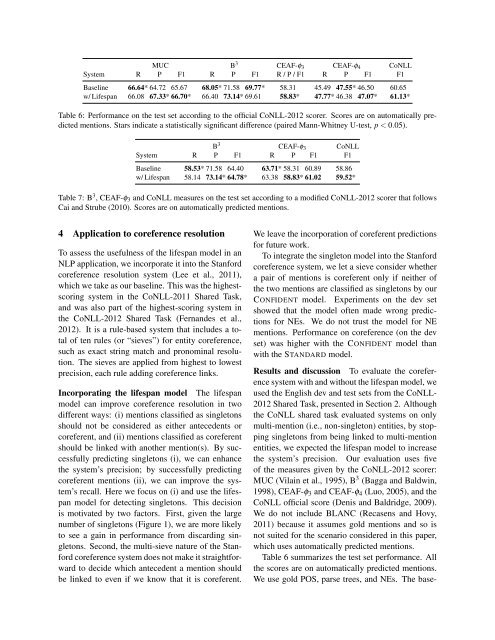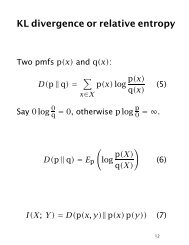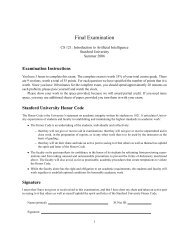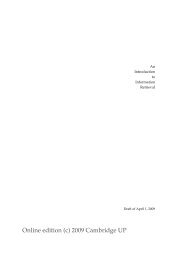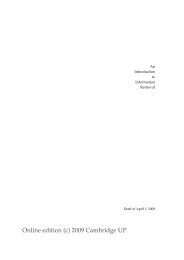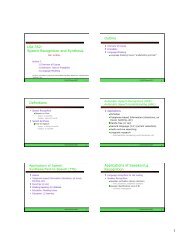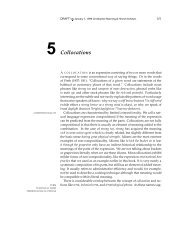The Life and Death of Discourse Entities: Identifying Singleton ...
The Life and Death of Discourse Entities: Identifying Singleton ...
The Life and Death of Discourse Entities: Identifying Singleton ...
Create successful ePaper yourself
Turn your PDF publications into a flip-book with our unique Google optimized e-Paper software.
MUC B 3 CEAF-φ3 CEAF-φ4 CoNLL<br />
System R P F1 R P F1 R / P / F1 R P F1 F1<br />
Baseline 66.64* 64.72 65.67 68.05* 71.58 69.77* 58.31 45.49 47.55* 46.50 60.65<br />
w/ <strong>Life</strong>span 66.08 67.33* 66.70* 66.40 73.14* 69.61 58.83* 47.77* 46.38 47.07* 61.13*<br />
Table 6: Performance on the test set according to the <strong>of</strong>ficial CoNLL-2012 scorer. Scores are on automatically predicted<br />
mentions. Stars indicate a statistically significant difference (paired Mann-Whitney U-test, p < 0.05).<br />
B 3 CEAF-φ3 CoNLL<br />
System R P F1 R P F1 F1<br />
Baseline 58.53* 71.58 64.40 63.71* 58.31 60.89 58.86<br />
w/ <strong>Life</strong>span 58.14 73.14* 64.78* 63.38 58.83* 61.02 59.52*<br />
Table 7: B 3 , CEAF-φ3 <strong>and</strong> CoNLL measures on the test set according to a modified CoNLL-2012 scorer that follows<br />
Cai <strong>and</strong> Strube (2010). Scores are on automatically predicted mentions.<br />
4 Application to coreference resolution<br />
To assess the usefulness <strong>of</strong> the lifespan model in an<br />
NLP application, we incorporate it into the Stanford<br />
coreference resolution system (Lee et al., 2011),<br />
which we take as our baseline. This was the highestscoring<br />
system in the CoNLL-2011 Shared Task,<br />
<strong>and</strong> was also part <strong>of</strong> the highest-scoring system in<br />
the CoNLL-2012 Shared Task (Fern<strong>and</strong>es et al.,<br />
2012). It is a rule-based system that includes a total<br />
<strong>of</strong> ten rules (or “sieves”) for entity coreference,<br />
such as exact string match <strong>and</strong> pronominal resolution.<br />
<strong>The</strong> sieves are applied from highest to lowest<br />
precision, each rule adding coreference links.<br />
Incorporating the lifespan model <strong>The</strong> lifespan<br />
model can improve coreference resolution in two<br />
different ways: (i) mentions classified as singletons<br />
should not be considered as either antecedents or<br />
coreferent, <strong>and</strong> (ii) mentions classified as coreferent<br />
should be linked with another mention(s). By successfully<br />
predicting singletons (i), we can enhance<br />
the system’s precision; by successfully predicting<br />
coreferent mentions (ii), we can improve the system’s<br />
recall. Here we focus on (i) <strong>and</strong> use the lifespan<br />
model for detecting singletons. This decision<br />
is motivated by two factors. First, given the large<br />
number <strong>of</strong> singletons (Figure 1), we are more likely<br />
to see a gain in performance from discarding singletons.<br />
Second, the multi-sieve nature <strong>of</strong> the Stanford<br />
coreference system does not make it straightforward<br />
to decide which antecedent a mention should<br />
be linked to even if we know that it is coreferent.<br />
We leave the incorporation <strong>of</strong> coreferent predictions<br />
for future work.<br />
To integrate the singleton model into the Stanford<br />
coreference system, we let a sieve consider whether<br />
a pair <strong>of</strong> mentions is coreferent only if neither <strong>of</strong><br />
the two mentions are classified as singletons by our<br />
CONFIDENT model. Experiments on the dev set<br />
showed that the model <strong>of</strong>ten made wrong predictions<br />
for NEs. We do not trust the model for NE<br />
mentions. Performance on coreference (on the dev<br />
set) was higher with the CONFIDENT model than<br />
with the STANDARD model.<br />
Results <strong>and</strong> discussion To evaluate the coreference<br />
system with <strong>and</strong> without the lifespan model, we<br />
used the English dev <strong>and</strong> test sets from the CoNLL-<br />
2012 Shared Task, presented in Section 2. Although<br />
the CoNLL shared task evaluated systems on only<br />
multi-mention (i.e., non-singleton) entities, by stopping<br />
singletons from being linked to multi-mention<br />
entities, we expected the lifespan model to increase<br />
the system’s precision. Our evaluation uses five<br />
<strong>of</strong> the measures given by the CoNLL-2012 scorer:<br />
MUC (Vilain et al., 1995), B 3 (Bagga <strong>and</strong> Baldwin,<br />
1998), CEAF-φ3 <strong>and</strong> CEAF-φ4 (Luo, 2005), <strong>and</strong> the<br />
CoNLL <strong>of</strong>ficial score (Denis <strong>and</strong> Baldridge, 2009).<br />
We do not include BLANC (Recasens <strong>and</strong> Hovy,<br />
2011) because it assumes gold mentions <strong>and</strong> so is<br />
not suited for the scenario considered in this paper,<br />
which uses automatically predicted mentions.<br />
Table 6 summarizes the test set performance. All<br />
the scores are on automatically predicted mentions.<br />
We use gold POS, parse trees, <strong>and</strong> NEs. <strong>The</strong> base-


